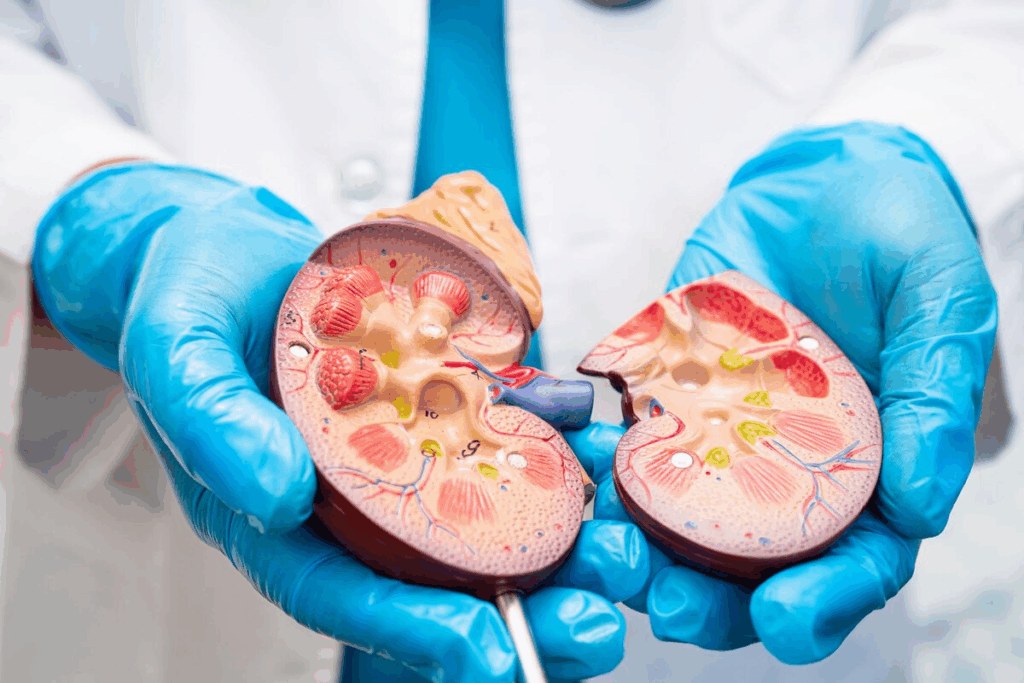
Kidney stones and bladder stones are two urinary tract issues that cause pain. They are similar but different in how they form, symptoms, and treatment.
Kidney stones are hard mineral deposits in the kidneys. They cause severe pain in the side or back, below the ribs. Bladder stones are hard masses in the bladder. They cause pain or discomfort in the lower abdomen.
Compare bladder stones vs kidney stones symptoms. Learn the key differences in where the pain occurs and the type of discomfort.
Knowing the differences between these conditions is key for proper treatment. We will look at their causes, symptoms, and treatment options in this section.
The urinary system is key to our body’s health. It helps get rid of waste and extra fluids. It includes the kidneys, ureters, bladder, and urethra.
Kidney stones are hard deposits that form in the kidneys. There are different types, like calcium stones and uric acid stones. Struvite and cystine stones are others.
Kidney stones and bladder stones are two different types of stones in the urinary tract. They can cause a lot of pain and health problems. Knowing the difference is key to getting the right treatment.
Kidney stones form in the kidneys, where urine is made. They can be caused by genetics, not drinking enough water, and some medical conditions. Bladder stones, on the other hand, form in the bladder. They are often linked to trouble passing urine, blockages, or neurogenic bladder.
The symptoms of kidney stones and bladder stones can be similar but different. Kidney stones can cause pain in the side, while bladder stones can hurt in the pelvic area. The treatment depends on the stone’s size, location, and how bad the symptoms are.
If symptoms don’t go away or get worse, you should see a doctor. A healthcare professional can diagnose and treat these conditions well.
Understanding the difference between kidney stones and bladder stones is the first step to getting the right medical care. This can help ease your symptoms.

Kidney stones, also known as renal calculi, form when there’s an imbalance in the urine. This imbalance causes minerals to crystallize and clump together. This forms stones.
Knowing how kidney stones form helps us understand risk factors and how to prevent them. We’ll look at dietary and genetic causes and the different types of stones.
Kidney stones form through nucleation, where minerals in the urine crystallize. Dehydration, a diet high in sodium, and certain medical conditions can trigger this process.
When urine is concentrated, it can’t dilute stone-forming substances. This leads to crystal formation. Over time, these crystals grow into stones, causing pain as they move through the urinary tract.
Several factors can increase the risk of getting kidney stones. These include:
Kidney stones can be classified into several types based on their composition. The most common types include:
Knowing the type of kidney stone is key to finding the right treatment and prevention.

Bladder stones are hard masses of minerals that form in the bladder. They often happen because of urinary retention or other health issues. Knowing the causes and symptoms is key to managing and treating them effectively.
Kidney stones and bladder stones are both types of urinary tract stones. They can cause a lot of discomfort and health problems. There’s a link between the two, even though they happen in different parts of the urinary system.
Kidney stones form in the kidneys, while bladder stones form in the bladder. But, small kidney stones can move down the urinary tract. They might get stuck in the bladder, helping to form bladder stones.
It’s important to understand how kidney stones and bladder stones are connected. This knowledge helps in preventing and treating these conditions. By knowing the risks and taking steps to prevent them, people can lower their chances of getting these stones.
Kidney stones and bladder stones can cause a lot of pain. They share some symptoms, but they are different.
Kidney stones often cause sharp pain on one side of the back or abdomen. This pain can spread to the lower abdomen. You might also feel nauseous and want to vomit.
Bladder stones make it hard to start or stop urinating. You might feel pain while urinating and need to go more often. Sometimes, you might see blood in your urine.
Symptom | Kidney Stones | Bladder Stones |
Pain Location | Back or side | Lower abdomen or pelvic area |
Urination Symptoms | Severe pain, nausea, vomiting | Difficulty starting or stopping urine flow, painful urination |
Diagnosing urinary stones requires several steps. These include imaging tests, lab tests, and a physical exam. These steps help doctors find out if you have stones, how big they are, and where they are. They also look for other health issues that might be causing the stones.
Imaging tests like CT scans and ultrasound are key. They help spot stones and figure out their size and where they are. Lab tests, such as urinalysis and stone analysis, reveal what the stones are made of and any underlying health problems.
After these tests, doctors create a treatment plan. This plan considers your overall health and medical history. It aims to treat the stones effectively.
Treatment for kidney stones varies based on the stone’s size and the patient’s health. For small stones, doctors might just use pain relief and plenty of water. But, bigger stones might need shock wave lithotripsy or surgery.
The main aim is to ease pain, avoid serious problems, and help the patient recover well.
Treating bladder stones requires a detailed plan. This plan considers the stone’s size, location, and why it formed.
Small stones might just need to be watched. But bigger stones often need to be surgically removed.
Every patient gets a treatment plan that fits their unique situation. This plan considers their medical history and overall health.
Untreated kidney and bladder stones can cause serious problems. It’s important to know these risks and take steps to prevent them. This helps keep your health in good shape.
To avoid these issues, staying hydrated and eating well is key. Also, managing any health conditions is important. Regular doctor visits and follow-ups can catch problems early.

To lower the chance of getting urinary stones, it’s key to have a plan. This plan should include drinking lots of water, eating right, and maybe taking medicine. It’s all about stopping stones before they start by fixing the problems that cause them.
Drinking enough water is vital to stop urinary stones. Drinking lots of water makes your urine less concentrated. This helps prevent minerals from sticking together and forming stones. Try to drink 8-10 glasses of water a day. But, how much you need can change based on how active you are, where you live, and more.
Changing what you eat is also important to stop stones from coming back. If you get calcium oxalate stones, eat less spinach and nuts. If you get uric acid stones, cut down on foods high in purines like organ meats and some seafood.
Sometimes, doctors will give you medicine to stop stones. For example, thiazide diuretics can lower calcium in your urine. This helps prevent calcium stones. Also, allopurinol can lower uric acid levels, which helps prevent uric acid stones.
By drinking plenty of water, eating wisely, and taking medicine if needed, you can greatly lower your risk of getting urinary stones.
Preventing kidney stones and bladder stones is a long-term effort. It involves adopting healthy habits and knowing the risk factors. By doing so, you can lower your chances of getting these conditions.
Kidney stones form in the kidneys, while bladder stones form in the bladder. Their causes and symptoms are different, leading to unique treatments.
Dehydration, a diet high in animal protein, sodium, and sugar, and certain medical conditions like hyperparathyroidism increase the risk of kidney stones.
Bladder stones are diagnosed with imaging tests like X-rays, CT scans, or ultrasound. A physical exam and medical history also play a role.
Symptoms of kidney stones include severe pain in the side or back, nausea, vomiting, and trouble urinating.
Treatment for kidney stones depends on the stone’s size, location, and the patient’s health. Options include pain management, hydration, and surgery.
Yes, bladder stones can be prevented by staying hydrated, avoiding certain foods, and managing medical conditions.
Kidney stones and bladder stones are both urinary stones but form in different parts. Kidney stones form in the kidneys, while bladder stones form in the bladder.
Drinking plenty of water, eating a balanced diet, and managing medical conditions can lower the risk of kidney stones.
Certain medications, like thiazide diuretics, can prevent kidney stones by reducing urine calcium levels.
Small kidney stones may pass on their own, but larger ones may need surgery.
Drinking plenty of water, taking pain medication, and resting can help manage symptoms while passing a kidney stone.
In some cases, bladder stones can be treated with medications or other non-surgical methods. Often, surgery is needed.
Staying hydrated, avoiding certain foods, and managing medical conditions can help prevent bladder stones.
National Health Service (NHS), Difference Between Kidney Stones and Bladder. Retrieved from https://www.nhs.uk/conditions/kidney-stones/
Subscribe to our e-newsletter to stay informed about the latest innovations in the world of health and exclusive offers!
WhatsApp us